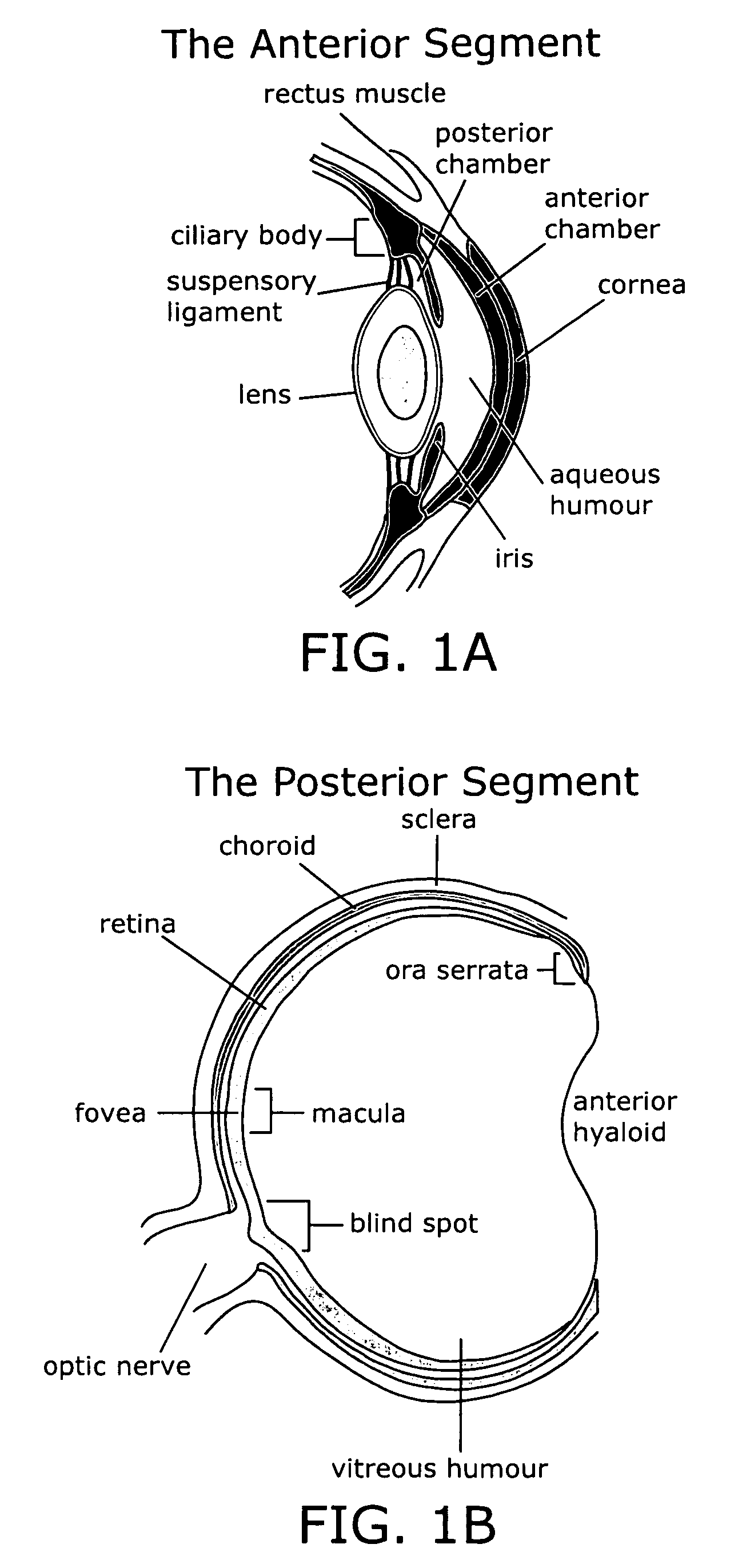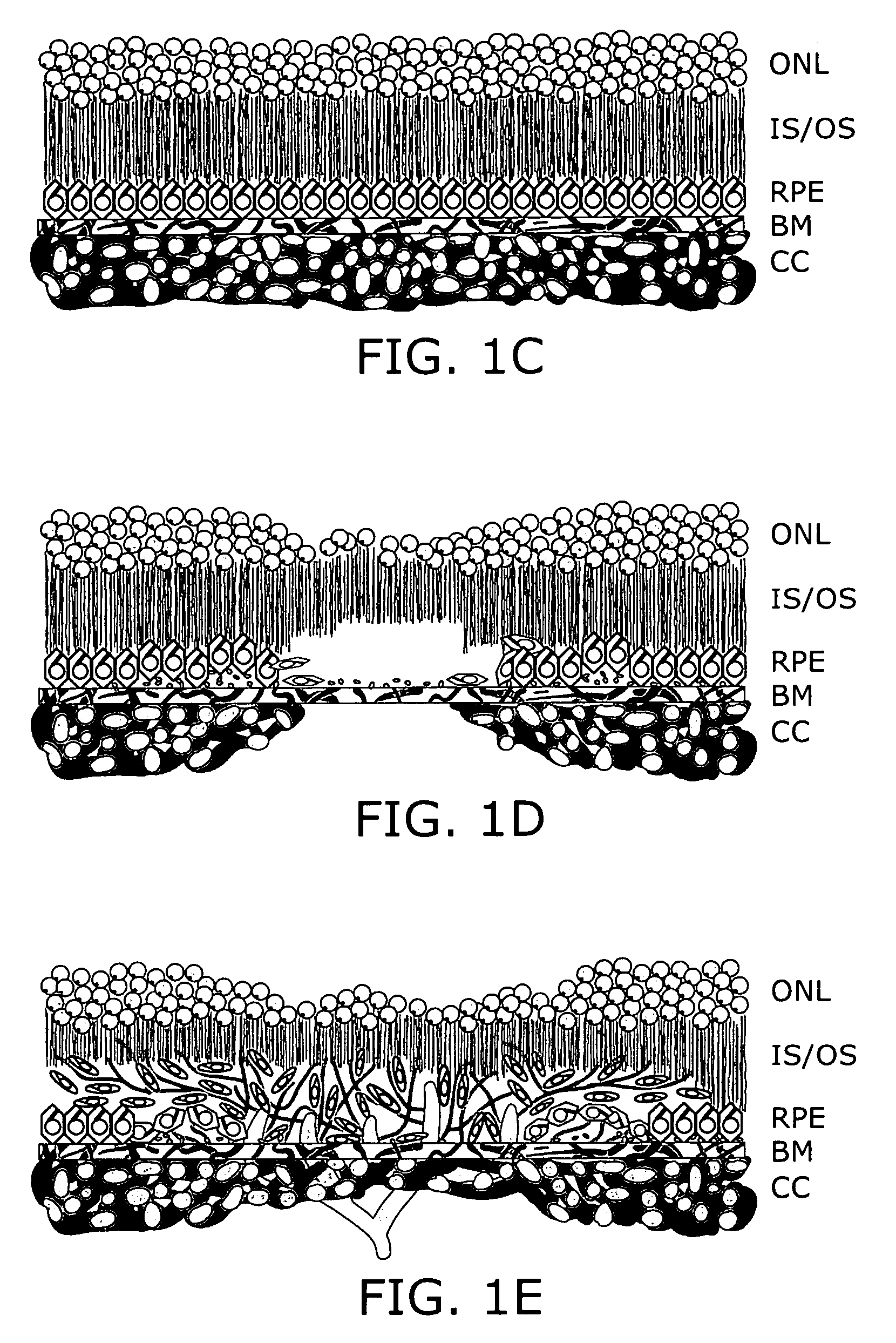Compositions and methods for treatment of macular degeneration and related conditions
a technology for applied in the field of compositions and methods for treating macular degeneration and related conditions, can solve the problems of photoreceptor degeneration, slow and progressive deterioration of central vision in patients with this form of armd, and unclear pathogenesis of armd
- Summary
- Abstract
- Description
- Claims
- Application Information
AI Technical Summary
Benefits of technology
Problems solved by technology
Method used
Image
Examples
example 1
Prevention of Choroidal Neovascularization in a Mouse Model by Administration of an Antagonist of a GPCR
[0174]Several GPCR antagonist compounds as discussed herein are produced as described in U.S. Pat. No. 6,821,950 and / or March, supra, and tested as described below. The compounds have the following sequences (i) AcF-(OPdChaWR), (ii) Suc-F-(OPdChaWR), (iii) AcF-(OPdPheWR) where abbreviations are listed above (Table 1) and ( ) denotes cyclization through an amide bond. Compounds are dissolved in sterile physiological saline. The experiment below is performed for each compound.
[0175]Mice (3 groups per dose; N=10 in each group) are anesthetized and their pupils dilated. Krypton red laser photocoagulation is used to generate multiple (e.g., 3-20) laser spots in each eye as described in Bora, 2003. For the first group, various doses of each compound (e.g., 1-100 μg) are administered by injection to one eye in each mouse at days 1 and 4 following laser treatment. The other eye serves as ...
example 2
Prevention of Choroidal Neovascularization in a Mouse Model by Administration of an Antagonist of a GPCRA
[0179]Several GPCR antagonist compounds as discussed herein are produced as described in U.S. Pat. No. 6,821,950 and / or March, supra, and / or Woodruff, supra, and tested as described below. One such compound referred to herein as GPCRA-1 has the sequence HCin-(OPdChaWR), where HCin=hydrocinnamate; dCHA=d-cyclohexylalanine; O=1-ornithine, and ( ) denotes cyclization through an amide bond. Compounds are dissolved in sterile physiological saline for injection or in sterile water for oral administration.
[0180]CNV Induction in Mice
[0181]C57BL / 6 mice (The Jackson Laboratory) are anesthetized with a mixture of ketamine / xylazine (8:1) and the pupils were dilated with a single drop of 1% tropicamide. Krypton red laser photocoagulation (50-μm spot size, 0.05 s duration, 250 mW) is used to generate laser spots surrounding the optic nerve by using a hand-held coverslip as a contact lens. Form...
example 3
Treatment with a GPCR Antagonist in a Mouse Model of Age Related Macular Degeneration
[0188]GPCRAs as described in Examples 1 and 2 are individually and in combination administered to 15, 16, or 18 month old normal mice and age-matched mice deficient in Ccl-2 and / or Ccr-2 (Ambati, et al.). In addition, combinations of a GPCR antagonist and VCP or SPICE are tested using similar amounts of these agents. Administration is performed by injection to one eye. The other eye serves as a control. In another experiment the compound or compound combination is administered intravenously. Various doses (as in Example 1) and treatment regimens are used. For example, in some groups the compound(s) are injected every 3 days. In other groups the compound(s) are injected weekly. The mice are sacrificed at various time points and their eyes are processed and analysed as described in Example 1. The ability of the compounds and compound combinations to prevent and / or treat CNV, RNV, or other features of ...
PUM
| Property | Measurement | Unit |
|---|---|---|
| Fraction | aaaaa | aaaaa |
| Composition | aaaaa | aaaaa |
| Pharmaceutically acceptable | aaaaa | aaaaa |
Abstract
Description
Claims
Application Information
 Login to View More
Login to View More - R&D
- Intellectual Property
- Life Sciences
- Materials
- Tech Scout
- Unparalleled Data Quality
- Higher Quality Content
- 60% Fewer Hallucinations
Browse by: Latest US Patents, China's latest patents, Technical Efficacy Thesaurus, Application Domain, Technology Topic, Popular Technical Reports.
© 2025 PatSnap. All rights reserved.Legal|Privacy policy|Modern Slavery Act Transparency Statement|Sitemap|About US| Contact US: help@patsnap.com



